Johnny Johnson did not have a master’s degree – not yet. He’d taught first through twelfth grades for a decade, had coached basketball and given art lessons to inmates. He was also an artist in his own right, with a following of Washington, D.C., professionals who drove to Fredericksburg to buy his work.
But in 1968, the year UMW came calling, he’d never instructed on a college campus. In fact, a civil rights group of which Johnson served as president had once been barred from holding meetings here because its membership was integrated. Now the college wanted Johnson – an African-American – to teach an art education class.
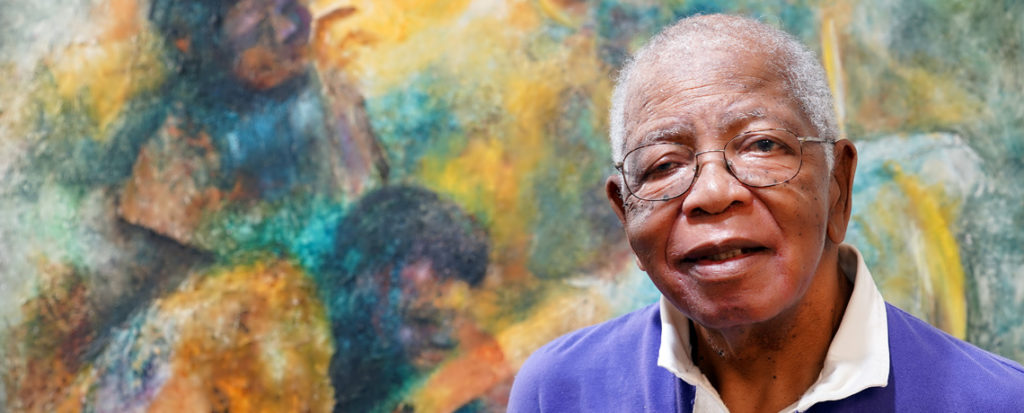
Times were changing. So was the university. Johnson accepted the job, becoming the first black faculty member. He stayed on as an adjunct professor for two decades, as his reputation as an artist, educator and humanitarian burgeoned far beyond the region.
On Saturday, July 7, Fredericksburg honored his achievements with the first-ever Johnny Johnson Day. The festivities were organized by the Arts and Cultural Council of the Rappahannock. UMW honored his legacy with a private luncheon at the president’s residence at Brompton.
“He came at a time when the university was making a choice to be more active and intentional in its efforts toward diversity and inclusion and civil rights,” said Sabrina Johnson, UMW’s vice president for equity and access. “It’s important to remember that and to celebrate that as we continue in this journey.”
Johnson was an artist before he fully understood what the word meant. At age 3, on a church pew next to his mother in their native Henderson, N.C., he outlined figures in the air. When he went off to school, he filled up the margins of his textbooks with drawings and spent hours making sketches on inexpensive typing paper.
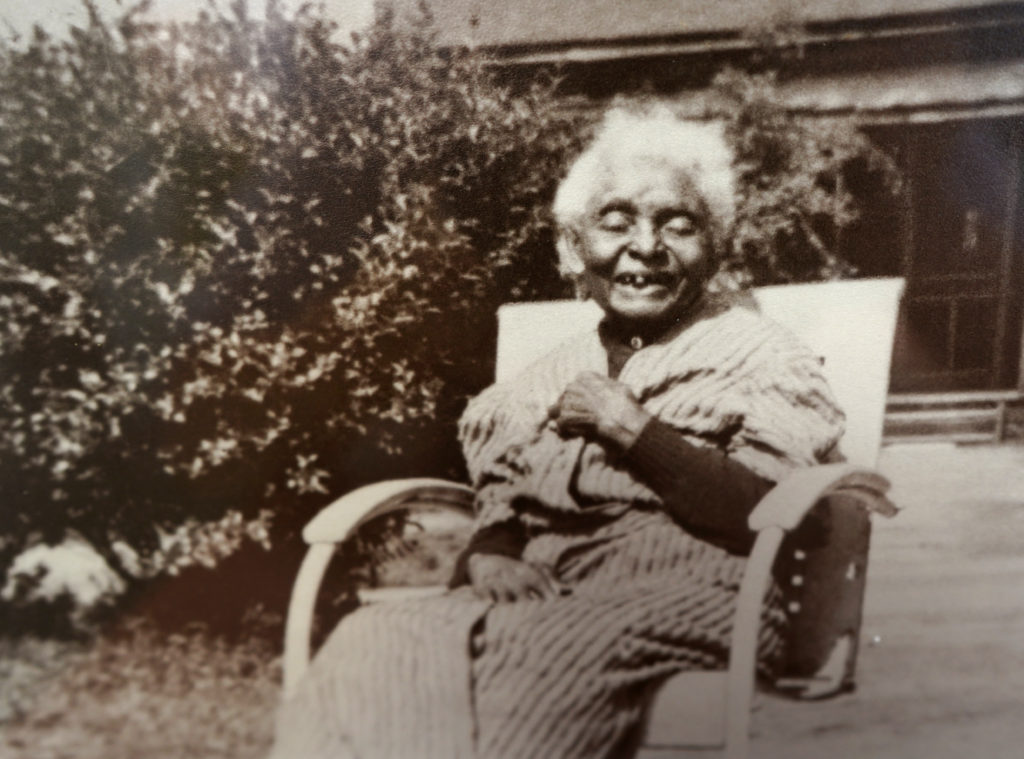
That wasn’t all that set him apart. He could also listen to music for hours; his childhood babysitter, Mammy Cook, a woman who’d been born into slavery and could remember Union soldiers walking into town, instilled that love in him. His favorite was Blind Boy Fuller, and a young Johnson would play his records on the Victrola.
He also excelled at sports – he would go on to captain the basketball team at Virginia State College and earn a spot in VSU’s Sports Hall of Fame – and he spoke with such precise grammar that a school teacher asked him if he’d been born somewhere else because he didn’t sound like other kids.
“I wanted to be like other kids,” he said. “I didn’t want to sound like I was trying to be somebody.”
He had his extraordinary sister, Helen, to thank for that. Six years his senior, Helen corrected Johnson every time he misspoke and taught him to stand up when a lady entered the room and walk on the outside of the sidewalk in the company of women.
“She had me quoting Shakespeare in seventh grade,” Johnson said. When he went off to college, she sent his letters back with corrections.
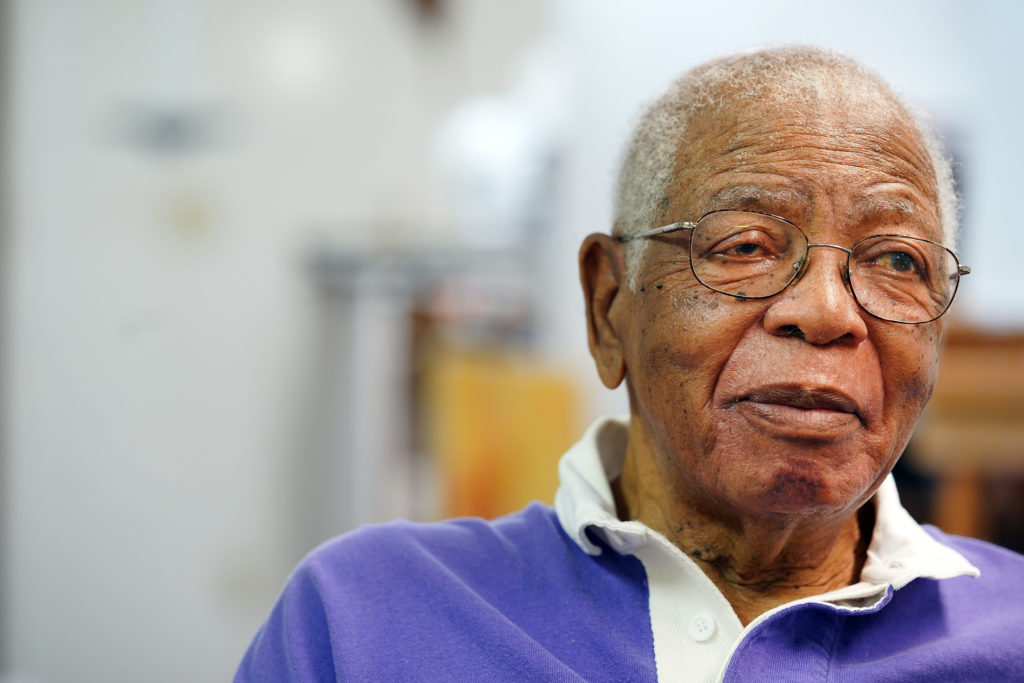
In 1959, Johnson accepted a job at Walker-Grant in Fredericksburg, where he taught both a sixth grade class and art to first through twelfth graders nearly a decade before the school system desegregated. The superintendent who interviewed him wanted to make sure the young teacher wasn’t from somewhere up North, coming to Virginia to try to integrate.
Johnson told the man he wanted a job. But he didn’t say he wouldn’t join in the cause for civil rights, of which the nation was on the brink. When Martin Luther King was assassinated, the educator joined in a march down Princess Anne Street. He helped channel the unrest of that emotionally-wrought summer into a Young Men’s Club. And he continued his work on the Fredericksburg Council on Human Relations as its president.
His role in the group, made up of black and white residents and Mary Washington students, got him called into the superintendent’s office one afternoon in a meeting that Johnson thought would cost him his job.
It didn’t. In 1968, Johnson, by then a husband and soon-to-be father of two, began teaching art at Walker-Grant and James Monroe High School. Integration had at last come to the city’s schools.
It had also come to Mary Washington, which enrolled the first African-American student in 1962. Two years later, the Board of Visitors had formally adopted a desegregation policy. The first African-American student graduated from UMW the year Johnson arrived.
Still, Johnson was incredulous when he was asked to teach a course at the university. He felt he’d been hired because he was black rather than in spite of it.
“I couldn’t really understand my going over there. I think they just heard about me,” he said. “I think I did pretty well as a teacher.”
Johnson was, in fact, beloved.
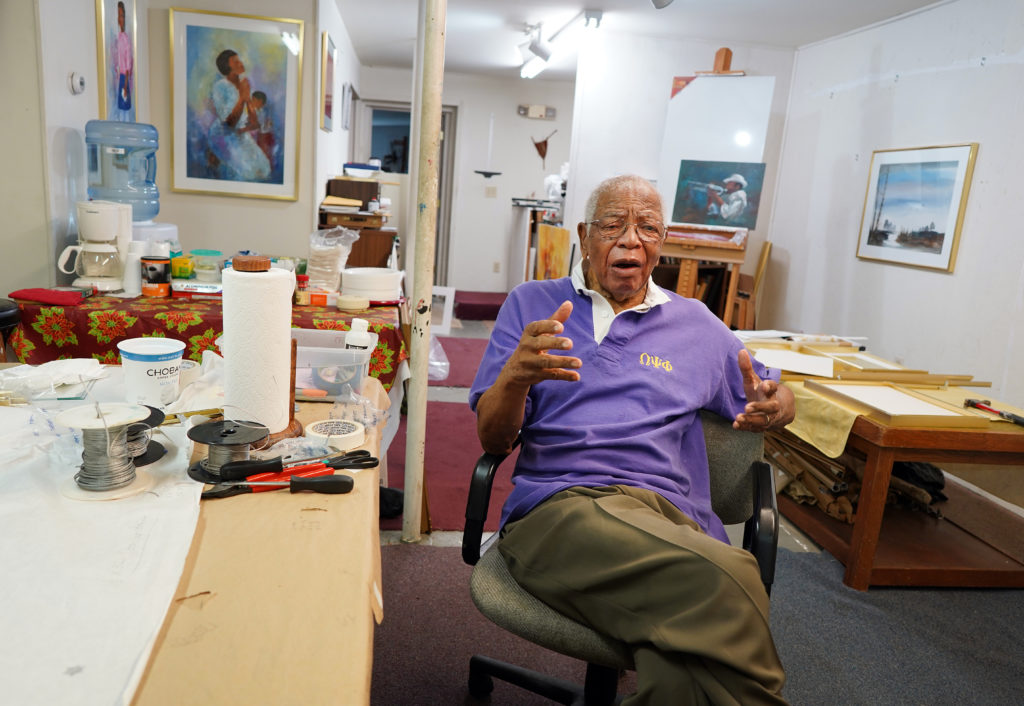
“What’s so special to me about him is there are very few people in this world who don’t see black or white. I think all of us have some prejudices. He loves everybody,” said Gaye Adegbalola, a Fredericksburg native and blues singer who was only the second African-American to attend UMW.
The man who worked in color was blind to it. He adopted a mantra: Everybody is somebody.
Adegbalola and Johnson’s careers crossed at James Monroe High School, where they both worked as teachers. “He called everybody LeRoy. It didn’t matter if you were a freshman, senior, male, female, black or white. It was just kind of a delightful that the name fit everybody.”
He never stopped giving, Adegbalola said, which spoke not only to Johnson’s character but that of his wife and sons, who shared him with the community that loved him. It was his donated artwork that went a long way toward supporting Harambee Theater, a group her father started to foster pride in African-American history and culture.
As an art education professor, Johnson introduced artists both black and white. “I told [students] to keep in mind that they might get a job in a predominately black community. I would share some personal experiences,” Johnson said, because these were the early days of integration.
Later, after they became educators themselves, many came back to him. “‘Johnny,’” they told him, “‘you were right on target.’ Those are the things I really appreciate.”
When a Mary Washington student asked him for a tube of flesh-colored paint, Johnson handed over a black one. “It was not to be funny, but to bring their attention to the fact that none of us are the same. You can take 10 white kids, and can’t find a color to fit just one. Sometimes, you have to mix the paint.”
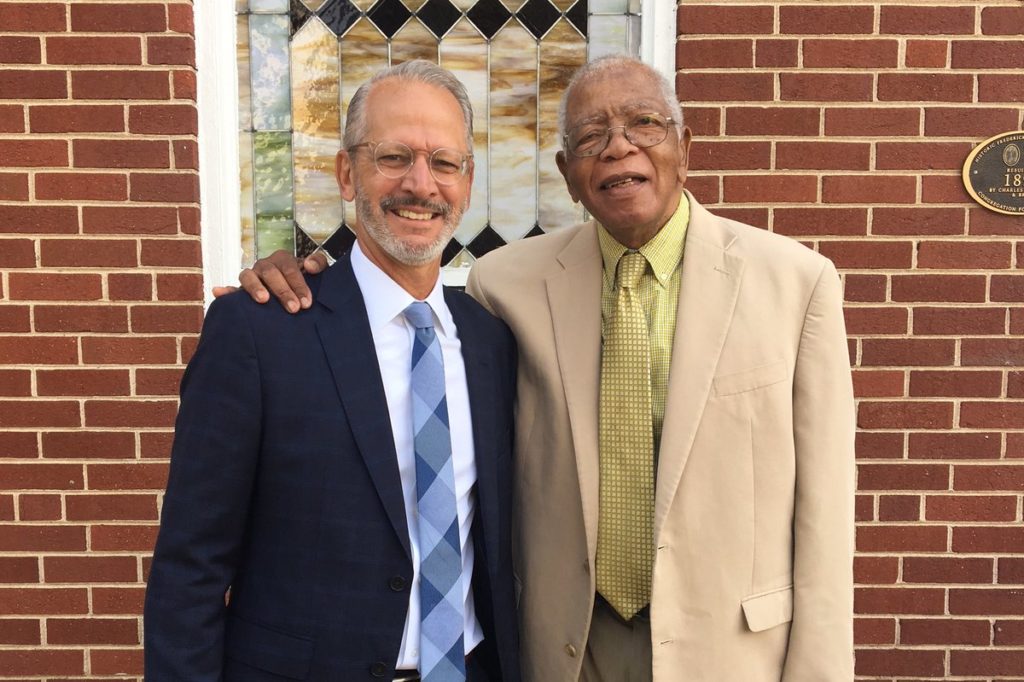
Johnson was a teacher, but he was also an artist. For many years, he taught in the city’s schools while also serving as an adjunct professor at Mary Washington and Germanna Community College and raising a family with his wife, Jean. He earned a master’s degree from Howard University. Still he painted.
During his nearly six decades in Fredericksburg, he has created thousands of artworks, first in the 9-by-7-foot studio in the family’s rented, upstairs apartment on Charles Street. The quarters were so cramped Johnson had to open the door and walk down the hall to see how the picture was coming along.
In 1970, when a funeral home vacated the two-story building across the street, Johnson seized the first floor for $30 a month to use as an art studio. It didn’t matter that there was no bathroom, or that an oil stove provided heat in winter, or that it was so full of moisture he collected enough water in a dehumidifier to paint with.
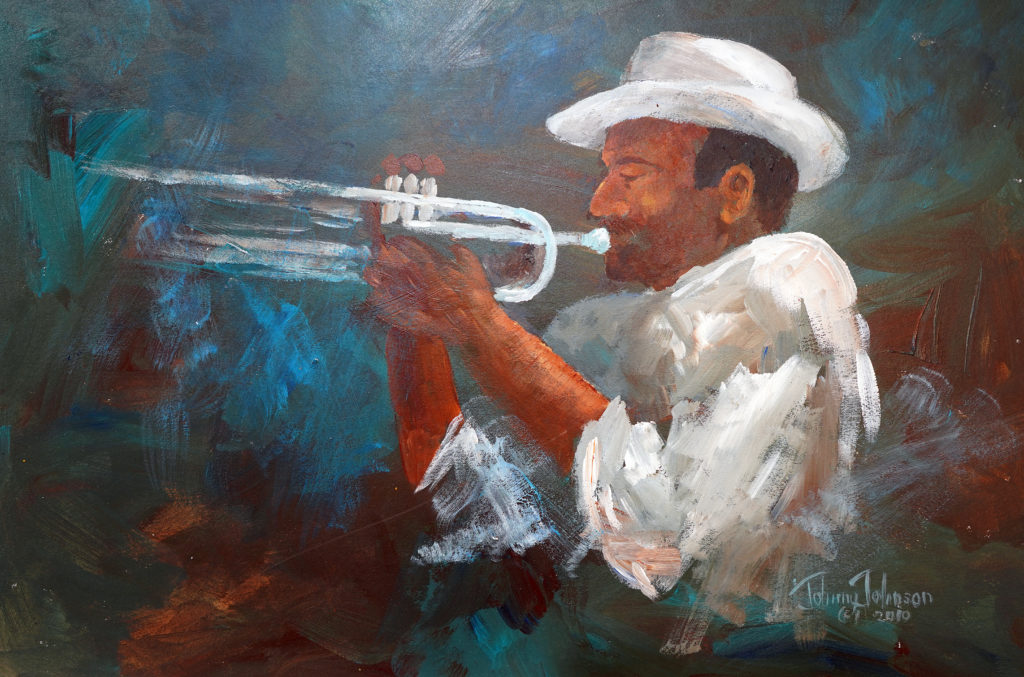
For the first time in his life, Johnson had all the space he could ever need for his art, which today hangs in embassies, banks, hospitals and homes as far-flung as Europe and Africa. His work took him to Jamaica and the African nation of Benin as a guest of long-time friend and U.S. Ambassador Pamela Bridgewater, herself a collector of Johnson’s art.
It was Bridgewater, a Fredericksburg native, who told the artist a few weeks ago about Johnny Johnson Day, much of which is being kept as a surprise to him.
“I was dumbfounded,” Johnson said this week in the same Charles Street studio he moved into so many years ago.
Today he owns it, and there is running water, but little else has changed. It is cluttered with paintings and art supplies and books, a microwave and a coffee pot and a stereo. On the wall near the entrance hangs a photograph of Mammy Cook. When he looks across the street, he can still see the window of his first art studio, at the center of the apartment where he raised his sons, Shelton and John Patrick, who inspired some of his most popular work.
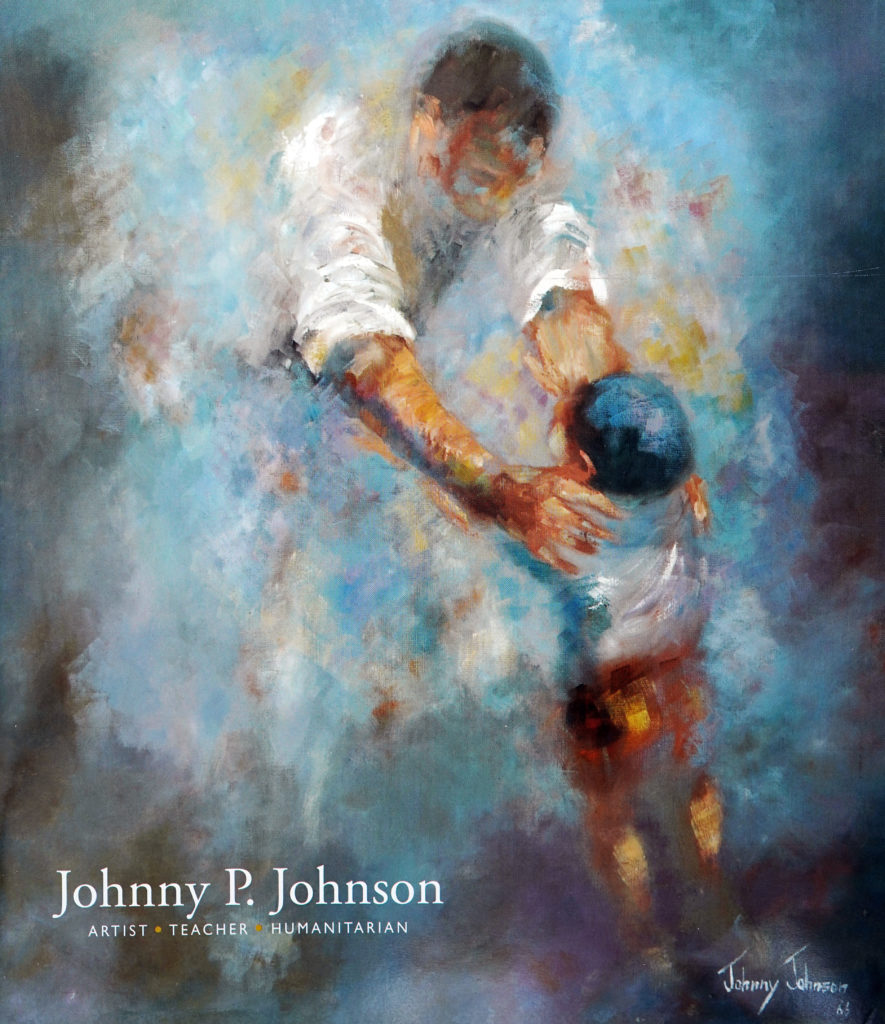
Johnson does not paint quite as much as he used to. A stroke two years ago slowed him down, he said. But he still picks up his brushes a few times a week. And although he retired from the school system in 1991, he never stopped teaching. To this day, he gives art workshops at the city’s community center.
He is not sure what to make over all that has been made about him. About Johnny Johnson Day.
“I guess you might say I was slightly embarrassed,” he said. “A lot has been given to me. The things I’ve done that people make a note of – they are things I think I was supposed to do.”
Yet like the canvases and the people he touched, Johnson made Fredericksburg all the more vibrant.
Congratulations. Awesome story.
He is a giant of a man, with a calm spirit. Fredericksburg is a better place because he decided to live here.
Congratulations, Johnny! You greatly deserve this honor. Thank your for what you have done for others, but a special thanks for your inspiration and support of my growth, as an artist. Best wishes in the future.
Ina Moss
So enjoyed reading about Mr. Johnson’s achievements and life story. I finished reading only wanting to know more about him? Would have enjoyed seeing more examples of his art. The two shown were just not enough to convey his talents. This man’s journey would justify a novel and the university should do a show of his art! I was left wanting to know more about Mr . Johnson and his art legacy.
His life
IS
an evolving picture
that
is
ART!
so happy that i can say i have met him and shared a few moments of his time/talent and humor
Johnny has touched and blessed so many lives in this area,including mine! I appreciate all the ways he has served the community and shared His love with all he has met!
Blessings, Johnny!
Well done story about a well loved man. Congratulations to Mr. Johnson!
Congratulations Mr. Johnson. I had graduated from Walker-Grant just before you came on the scene, but through the years I’ve heard about your accomplishments and outstanding achievements. May God bless your legacy and grant you many more years of outstanding works.
Johnny Johnson is one of the greatest men I know.. He gave humanitarian lessons to all of us as he went along his humble way. No one would ever say something out of character about Mr. Johnson. He is a deacon in the famed Shiloh (Old Site) Church and has been Sunday School superintendent for many years. When he came to Walker Grant to teach all of us were in awe of his basketball prowess… before his time, for sure… should have played in the NBA. Wonderful guy and the celebration in his honor was well deserved.. Thank God for this great Man of God..
What a man, what an artist, and what an American!
Al-Tony Gilmore, Ph.D
Bethesda, Maryland
Mr Johnson was my High School teacher …..he was also one heck of a basketball player. He taught me a thing or two. Mr Johnson is an icon to our town…. remembering the 1960s-70s. A wonderful man, loved by many.
Johnny P’s art studio was at 1311 Charles street. My Family lived at 1309 Charles Street. His family lived across the street at 1308 Charles Street. I was always in his upstairs studio watching him create. Not only was Johnny P a great neighbor, he was an inspiration to our entire family. My sister babysat both John Patrick and Shelton. I purchased several paintings from Johnny P. He and my sister are cornerstones of Shiloh Baptist Church. Whenever I purchased a painting, he would hand me another painting and say, “give this to Angela”…my oldest daughter. I cherish knowing the Johnson family since the 1950s. All honor to a great man, and a Charles Street legend!
I met Mr Johnny years ago as I tried to get into one of his art classes at the Dorothy Hart community center and finally made it He is the most awesome person that I have grown to love I learned so much from this great man and Cherish our friendship along with his Gene He and my late husband Larry had so much fun conversing about all the people they knew in the Burg He is truly a God send to us He deserves this honor bestowed on him wish I could have been there but was out of town He is a true loving person all my love to you Mr Johnny P from all the Snider’s
Johnny Johnson restarted my love of painting 6 years ago. I first met him in 1967 at the Dorothy Hart Community Center where he was one of the artists in the show. I fell in love with his “Mother and Child”painting. I just had my first child and this painting touched my heart. I met and talked with him and he asked me if I painted. I said I didn’t have time and he told me to make time – that it was important. Then 6 years ago I decided to join his watercolor class since that was on my “bucket list”. That opened up a part of me that had lain dormant for all those years. I’ve since done hundreds of paintings, first in watercolor, then acrylics and then alcohol ink. His inspiration, knowledge and most of all his positive encouragement and delight over every painting has been the spark to keep me enjoying (actually loving) painting.
God loves you, Johnny Johnson and so do I
What an inspirational man…what I would call a true Renaissance man! He is gifted in art, athletics, education, religion, and civility. I wish I had known him, but he arrived the year I left Mary Washington. I would also LOVE to see more of his art! How wonderful that he has been honored for his many contributions to Fredericksburg, to the schools who were lucky to have him, and to America.
Mr. Johnson was a great teacher. Loved my class with him.
It has been wonderful to witness the very well deserved celebration of our dear friend Johnny P. Johnson! Although our paths cross infrequently, I have heart warming memories of times spent with him. One of my favorites was when my two children (then ages 3 and 6) stopped by his Charles Street studio just to chat. While we were there he picked out a large piece of paper (14″ by 3′) and painted a watercolor of a sweet clown (yes, clowns were one of the many series that Johnny has done). At the bottom he wrote to Mike and Dana from Johnny Johnson 4/75. The time we spent with him was magical for these two young children.
Johnny, thank you for being you – full of love, caring and encouragement. And, Jean, thank you for sharing him with us all!
Have missed seeing you, Johnny, during
recent visits to Fburg. You were a lovely student teacher supervisor and MW teacher for me and your 1970s painting you gave to me still hangs on my foyer wall at home😍
Congratulations! I remember Mr Johnson when I attended MWC (as it was known in the 70’s) If I remember correctly, he was the ONLY African-American instructor on campus, and the few women of color were thrilled to see him. He was warm, friendly, and welcoming, even if we didn’t take an art class. A living treasure to the art world, the university, and the city of Fredericksburg.
I worked with Johnny Johnson at the Tree House and James Monroe HS, when I attended MWC in the 70’s! He was such a kind and caring person and always wanted the best for everyone! Thank you, once again, for everything you did for me and for the community…Congratulations, Mr. Johnson!
Thanks to the Arts & Cultural Council and others who provided the well deserved Celebration of Johnny Johnson events to rejoice with him in his legacy as a beloved icon in our community. Johnny has generously shared his art, time and love with so many of us, who have benefited from his wisdom and friendship. His art hangs on my walls and in the homes of my daughters, bringing joy to our lives everyday. The mural by Bill Harris is a wonderful tribute to Johnny and his art–a fitting welcome to downtown. I can’t find enough words to express how fortunate I feel that Johnny P. Johnson chose to make Fredericksburg his home and to have taken time to be my mentor as a teacher and an artist. Thank you, Johnny.